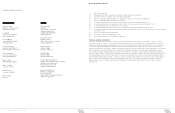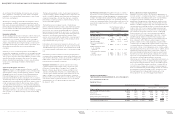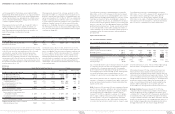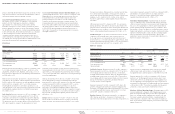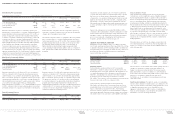Equifax 2013 Annual Report Download - page 15
Download and view the complete annual report
Please find page 15 of the 2013 Equifax annual report below. You can navigate through the pages in the report by either clicking on the pages listed below, or by using the keyword search tool below to find specific information within the annual report.
25 EQUIFAX 2013 ANNUAL REPORT
The goodwill balance at December 31, 2013, for our nine reporting
units was as follows:
December 31,
(In millions) 2013
Consumer Information Solutions $ 971.4
ID Management 61.1
Europe 124.2
Latin America 247.5
Canada Consumer 29.3
North America Personal Solutions 16.7
North America Commercial Solutions 37.2
Verification Services 738.7
Employer Services 169.0
Total goodwill $2,395.1
We performed a qualitative assessment to determine whether further
impairment testing was necessary for our Consumer Information
Solutions, Europe, Canada Consumer, North America Personal Solu-
tions, North America Commercial Solutions, Verification Services and
Employer Services reporting units. In this qualitative assessment, we
considered the following items for each of the reporting units: macro-
economic conditions, industry and market conditions, overall financial
performance and other entity specific events. In addition, for each of
these reporting units, the most recent fair value determination
resulted in an amount that exceeded the carrying amount of the
reporting units. Based on these assessments, we determined the
likelihood that a current fair value determination would be less than
the current carrying amount of the reporting unit is not more likely
than not. As a result of our conclusions, no further testing was
required for these reporting units.
Judgments and Uncertainties — In determining the fair value the
ID Management and Latin America reporting units for which we
performed a quantitative test, we used a combination of the income
and market approaches to estimate the reporting unit’s business
enterprise value.
Under the income approach, we calculate the fair value of a reporting
unit based on estimated future discounted cash flows which require
assumptions about short and long-term revenue growth rates,
operating margins for each reporting unit, discount rates, foreign cur-
rency exchange rates and estimates of capital charges. The
assumptions we use are based on what we believe a hypothetical
marketplace participant would use in estimating fair value. Under the
market approach, we estimate the fair value based on market
multiples of revenue or earnings before income taxes, depreciation
and amortization, for benchmark companies. We believe the
benchmark companies used for each of the reporting units serve as
an appropriate input for calculating a fair value for the reporting unit
as those benchmark companies have similar risks, participate in
similar markets, provide similar services for their customers and
compete with us directly. The companies we use as benchmarks are
principally outlined in our ‘‘Competition’’ discussion in Item 1 of our
2013 Form 10-K. Data for the benchmark companies was obtained
from publicly available information. Latin America and ID Management
have benchmark companies that conduct operations of businesses
of a similar type, such as Experian Group Limited and Fair Isaac
Corporation. Valuation multiples were selected based on a financial
benchmarking analysis that compared the reporting unit’s operating
result with the comparable companies’ information. In addition to
these financial considerations, qualitative factors such as variations in
growth opportunities and overall risk among the benchmark
companies were considered in the ultimate selection of the multiple.
The values separately derived from each of the income and market
approach valuation techniques were used to develop an overall
estimate of a reporting unit’s fair value. We use a consistent
approach across all reporting units when considering the weight of
the income and market approaches for calculating the fair value of
each of our reporting units. This approach relies more heavily on the
calculated fair value derived from the income approach, with 70% of
the value coming from the income approach. We believe this
approach is consistent with that of a market participant in valuing
prospective purchase business combinations. The selection and
weighting of the various fair value techniques may result in a higher or
lower fair value. Judgment is applied in determining the weightings
that are most representative of fair value.
We have not made any material changes to the valuation methodol-
ogy we use to assess goodwill impairment since the date of the last
annual impairment test.
Growth Assumptions
The assumptions for our future cash flows begin with our historical
operating performance, the details of which are described in our
Management’s Discussion & Analysis of operating performance.
Additionally, we consider the impact that known economic, industry
and market trends will have on our future forecasts, as well as the
impact that we expect from planned business initiatives including new
product initiatives, client service and retention standards, and cost
management programs. At the end of the forecast period, the long-
term growth rate we used to determine the terminal value of each
reporting unit was 3% based on management’s assessment of the
minimum expected terminal growth rate of the reporting unit, as well
as broader economic considerations such as GDP, inflation and the
maturity of the markets we serve.
We projected revenue growth in 2014 for our reporting units in
completing our 2013 impairment testing based on planned business
initiatives and prevailing trends exhibited by these units and not
based on the assumption of meaningful acceleration in economic
growth. The anticipated revenue growth in our reporting units,
however, is partially offset by assumed increases in expenses for a
majority of our reporting units which reflect the additional level of
investment needed in order to achieve the planned revenue growth.
Our 2014 long-term forecast is not dependent upon meaningful
MANAGEMENT’S DISCUSSION AND ANALYSIS OF FINANCIAL CONDITION AND RESULTS OF OPERATIONS continued
26 EQUIFAX 2013 ANNUAL REPORT
acceleration of global economic growth in the near term and we
continue to take cost containment actions to help maintain operating
margins for our reporting units.
Discount Rate Assumptions
We utilize a weighted average cost of capital, or WACC, in our
impairment analysis that makes assumptions about the capital
structure that we believe a market participant would make and
include a risk premium based on an assessment of risks related to
the projected cash flows of each reporting unit. We believe this
approach yields a discount rate that is consistent with an implied rate
of return that a market participant would require for an investment in
a company having similar risks and business characteristics to the
reporting unit being assessed. To calculate the WACC, the cost of
equity and cost of debt are multiplied by the assumed capital
structure of the reporting unit as compared to industry trends and
relevant benchmark company structures. The cost of equity was
computed using the Capital Asset Pricing Model which considers the
risk-free interest rate, beta, equity risk premium and specific company
risk premium related to a particular reporting unit. The cost of debt
was computed using a benchmark rate and the Company’s tax rate.
For the 2013 annual goodwill impairment evaluation, the discount
rates used to develop the estimated fair value of the reporting units
evaluated were 11% and 17%. Because of assigned market
premiums, discount rates are lowest for reporting units, whose cash
flows are expected to be less volatile due to such factors as the
maturity of the market they serve, their position in that market or
other macroeconomic factors. Where there is the greatest volatility of
cash flows due to competition, or participation in less stable
geographic markets than the United States, such as our Latin
America reporting unit, the discount rate selected is in the higher por-
tion of the range as there is more inherent risk in the expected cash
flows of that reporting unit.
Estimated Fair Value and Sensitivities
The estimated fair value of the reporting units whose fair value was
calculated for purposes of the 2013 impairment testing is derived from
the valuation techniques described above, incorporating the related
projections and assumptions. An indication of possible impairment
occurs when the estimated fair value of the reporting unit is below the
carrying value of its equity. The estimated fair value for these reporting
units exceeded their related carrying value as of September 30, 2013.
As a result, no goodwill impairment was recorded.
The estimated fair value of the reporting unit is highly sensitive to
changes in these projections and assumptions; therefore, in some
instances changes in these assumptions could impact whether the
fair value of a reporting unit is greater than its carrying value. For
example, an increase in the discount rate and decline in the projected
cumulative cash flow of a reporting unit could cause the fair value of
certain reporting units to be below its carrying value. We perform
sensitivity analyses around these assumptions in order to assess the
reasonableness of the assumptions and the resulting estimated fair
values. Ultimately, future potential changes in these assumptions may
impact the estimated fair value of a reporting unit and cause the fair
value of the reporting unit to be below its carrying value. The excess
of fair value over carrying value for the Company’s reporting units that
were valued as of September 30, 2013, were 27% and 40%.
No new indications of impairment existed during the fourth quarter of
2013, thus no impairment testing was updated as of December 31,
2013.
Effect if actual results differ from assumptions — We believe that our
estimates are consistent with assumptions that marketplace
participants would use in their estimates of fair value. However, if
actual results are not consistent with our estimates and assumptions,
we may be exposed to an impairment charge that could be material.
Loss Contingencies
We are subject to various proceedings, lawsuits and claims arising in
the normal course of our business. We determine whether to disclose
and/or accrue for loss contingencies based on our assessment of
whether the potential loss is probable, reasonably possible or remote.
Judgments and uncertainties — We periodically review claims and
legal proceedings and assess whether we have potential financial
exposure based on consultation with internal and outside legal
counsel and other advisors. If the likelihood of an adverse outcome
from any claim or legal proceeding is probable and the amount can
be reasonably estimated, we record a liability on our Consolidated
Balance Sheets for the estimated settlement costs. If the likelihood of
an adverse outcome is reasonably possible, but not probable, we
provide disclosures related to the potential loss contingency. Our
assumptions related to loss contingencies are inherently subjective.
Effect if actual results differ from assumptions — We do not believe
there is a reasonable likelihood that there will be a material change in
the future estimates or assumptions we use to determine loss
contingencies. However, if facts and circumstances change in the
future that change our belief regarding assumptions used to
determine our estimates, we may be exposed to a loss that could be
material.
Income Taxes
We record deferred income taxes using enacted tax laws and rates
for the years in which the taxes are expected to be paid. We assess
the likelihood that our net deferred tax assets will be recovered from
future taxable income or other tax planning strategies. To the extent
that we believe that recovery is not likely, we must establish a valua-
tion allowance to reduce the deferred tax asset to the amount we
estimate will be recoverable.
Our income tax provisions are based on assumptions and calcula-
tions which will be subject to examination by various tax authorities.
We record tax benefits for positions in which we believe are more


